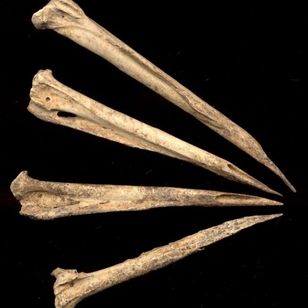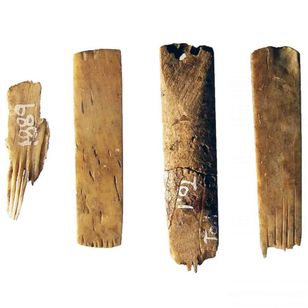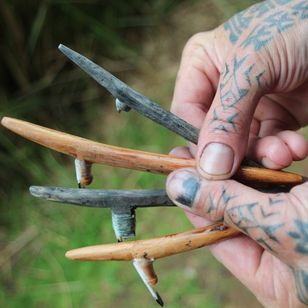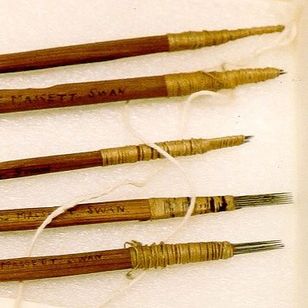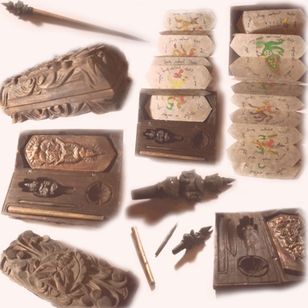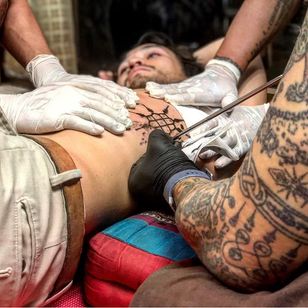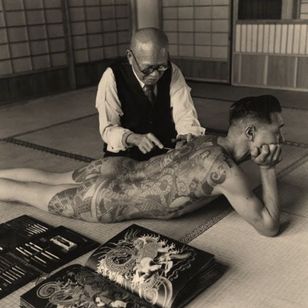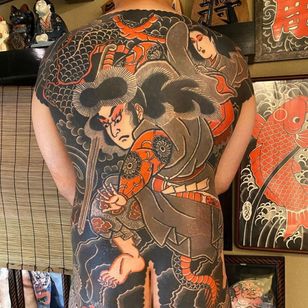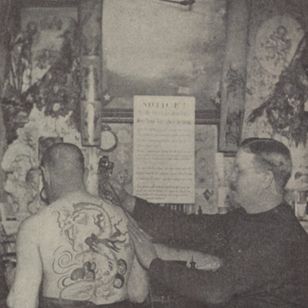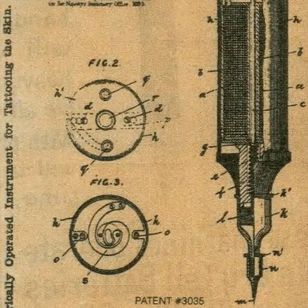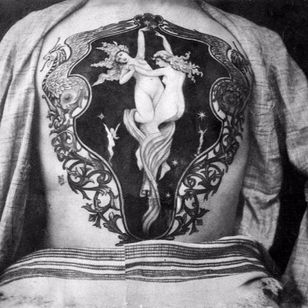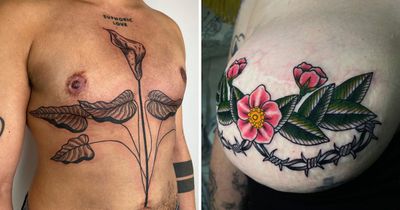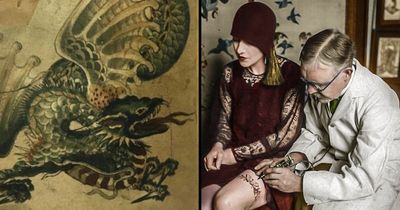A Short History of Tattoo Tools
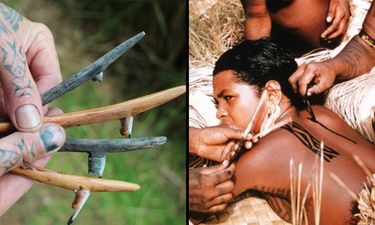
Summary
We give you a quick look at how tattoo tools have developed from ancient times to modern day.
Tattooing is a centuries old art form and throughout the years, there have been significant changes to the methods used in the process. Read on to discover how tattoo tools have progressed from ancient bronze needles and chisels made of bone, right up to contemporary tattoo machines as we know them.
Ancient Tattoo Tools
Ancient Egyptian Tattoo Tools
Figural tattoos depicting animals and ancient gods, have been discovered on Egyptian mummies dating back to somewhere between 3351–3017 BC. Web-like geometric patterns were also inked into the skin as a form of protection against evil spirits and even death.
These designs were made up of a carbon-based pigment, likely soot, that was inserted into the dermis layer of the skin using a multi-needle tattoo tool. This meant that large areas could be covered more quickly and rows of dots or lines achieved together.
Each needle point was made from a rectangular piece of bronze folded inwards at one end and hammered into shape. Several needles were then strapped together, attached to a wooden handle, and dipped into the soot ready for embedding the design into the skin.
Ta Moko tools
Polynesian tattooing is famous for its beautiful designs and lengthy history. Maori tattooing, in particular, also known as Ta Moko, is traditionally practised by the indigenous people of New Zealand. These inkings were, and are still, highly sacred. With a focus on tattooing the face, each design was used to represent membership to a particular tribe, with a specific location to signify rank and status.
Traditionally, a tattoo tool called a Uhi made from sharpened bone with a wooden handle was used to create the unique infill patterns. However, before embedding the ink made from burnt wood, cuts were first made in the skin. The pigment would then be drummed into these furrows using the ¼ inch chisel-like tool.
Like many other Polynesian island tribe traditions, Ta Moko largely died out in the mid-19th century after colonisation. However, it has since seen a magnificent revival thanks to modern Maori who are passionate about preserving their tribal rites.
Dayak Tattoo Techniques
The Dayak of Borneo are another tribe that has been practicing tattooing for hundreds of years. For their tattoos, a needle was fashioned from the thorns of orange trees while the ink is made from a mixture of soot and sugar. The designs of Dayak tattoos are sacred, and there are multiple reasons why someone of this tribe may get tattooed: to celebrate a special occasion, sexual maturity, the birth of a child, social status or interests, and more.
Dayak tattoo needle, holder, and ink cup. #Dayak #borneo #tattootools #tattoosupplies #tattoohistory #tattooculture
Haida Tattoo Tools
The Haida people who have lived on an island off the Western coast of Canada for about 12,500 years. Though their tools resemble Japanese tebori instruments, the way of application is different, as are the ceremonies in conjunction with a sacred tattoo session.
Via Lars Krutak, "Haida tattooing seemed to be quite rare by 1885. Traditionally, it was performed in conjunction with the potlatch commemorating the completion of a cedar-plank dwelling and its frontal pole. Potlatches entailed the distribution of personal property by the host (house chief) to those who had performed important functions in the actual construction of the house. Each gift elevated the status of the house chief and his family and especially benefited the house owner's children. After the lengthy exchange of goods, each child of the house chief received a new potlatch name and costly tattoo that accorded them high-ranking status."
Long sticks with needles attached were used for application and lignite stones were used as ink. Anthropologist J.G. Swan, who witnessed a Haida tattoo ceremony around 1900, collected many of their tattoo tools and wrote on the labels a detailed description. One of which says, ""Paint stone for grinding lignite for painting or for Tattooing. For paint, ground with salmon eggs & for tattooing, ground with water".
Interestingly, the Haida people are one of the few tribes who used red pigments, as well as black, to create their tribal tattoos.
Early Modern Tattoo Tools
Thai Sak Yant
This ancient Thai tattooing tradition dates back to the 16th century, when Naresuan ruled and his soldiers sought spiritual protection ahead of battles. It remains popular to this day, and there’s even an annual religious celebration dedicated to it.
A Yant is a sacred geometric design that offers various blessings and protection through Buddhist Psalms. When combined, ‘Sak Yant’ means magic tattoo. Prayers are chanted during the tattooing process to infuse the tattoo with spiritual powers of protection. The belief is that the closer the design is to the head, the better your luck will be.
Traditionally, Buddhist monks use long spikes made from sharpened bamboo or metal as their chosen tattoo tool. This was used to create Sak Yant tattoos that resemble a tapestry. This kind of hand-tapped tattoo requires both hands: one to guide the tool and one to tap the end of the rod to embed the ink into the skin. Oil is also sometimes used to create a charm that’s invisible to onlookers.
Japanese Tebori
The Tebori tattooing technique dates back to the 17th century and it has remained popular for centuries. In fact, up until around 40 years ago, all tattooing in Japan was done by hand.
Tebori literally means "to carve by hand" and the word comes from the woodblock craft; creating stamps out of wood to print images onto paper. In tattooing, it involves using a tattoo tool consisting of a set of needles attached to a wooden or metal rod known as a Nomi.
Artists guide the Nomi with one hand and use their other arm to manually push the ink into the skin using a rhythmic tapping motion. It is a much slower process than electric tattooing, but it can create a more saturated finish and a smoother graduation between shades.
A Tokyo Tebori artist known as Ryugen, told CNN that it took him 7 years to hone his skill: “It takes a longer time to master than (using a tattoo) machine. I think it is because there are many parameters, such as angle, speed, strength, timing and intervals between ‘pokes’.”
Victorian Era Tattoo Tools
Edison’s pen
Perhaps most famous for inventing the lightbulb and the motion picture camera, in 1875 Thomas Edison also invented an electric pen. Initially designed for making duplicates of the same document using a stencil and ink roller, the invention sadly never took off.
Edison’s pen was a hand-held implement with an electric motor mounted on the top. It required the operator to have advanced battery knowledge in order to maintain it and typewriters were much more accessible to the average person.
However, despite its initial flop, Edison’s motorised pen would set the stage for a completely different type of tool: the first electric tattoo machine.
Edisons Electric Pen #Edison #ElectricPen #tattoomachine #tattootools #tattoosupplies #tattoohistory #tattooculture
O’Reilly’s electric tattoo machine
15 years after Edison designed his electric pen, Irish-American tattooist Samuel O’Reilly was granted a US patent for the world’s first tattooing needle. Having made a name for himself in the tattoo industry during the late 1880s while tattooing in New York, O’Reilly began experimenting. His goal: a tool to speed up the process.
In 1891, inspired by the technology that went into Edison’s pen, O’Reilly added two needles, an ink reservoir and tweaked the angle of the barrel. And just like that, the first rotary tattoo machine was born.
Capable of performing 50 skin perforations per second, at least 47 more than the fastest and most experienced hand-poke artist, the machine revolutionised the tattooing industry and changed the course of future tattoo tools.
From then on, artists from all over the world started to design their own machines. London-based Tom Riley was the first, receiving a British patent for his single coil machine made from a modified doorbell assembly, just 20 days after O’Reilly was granted his.
Three years later, having worked with hand tools for several years, Riley’s rival Sutherland Macdonald also patented his own electric tattooing machine. In an 1895 article in The Sketch, Macdonald’s machine was described by a reporter as a: “little instrument [which] makes a somewhat strange whirring noise.”
Contemporary Tattoo Tools
Fast forward to 1929: American tattooist Percy Waters had developed the first modern tattoo machine with a familiar shape. After designing and manufacturing 14 frame styles, some of which are still used to this day, he became the leading tattoo tool supplier in the world.
It was then another 50 years before anyone else patented a tattoo machine. In 1978, Canadian-born Carol “Smokey” Nightingale developed a complex ‘electric marking device for tattooing humans’ with all kinds of customisable elements.
His design featured adjustable coils, leaf springs and movable contact screws for altering depth, challenging the idea that electric tattoo machines needed to have fixed components.
While the machine was never mass produced due to manufacturing difficulties, it showcased what was possible and set the stage for the adjustable, electromagnetic machines that are used in tattooing today.
Given how Edison and Nightingale’s accidental successes have helped to shape today’s booming tattoo industry as we know it, we’d dare say there’s a lot to be learnt from a little failure now and again…
